Our Home: Earth, a Unique Life-Sustaining Planet Chapter Notes | Chapter Notes For Class 8 PDF Download
What would Earth be like if it had never known life at all?
Our planet, Earth, is not just another ball of rock in space. It’s the only known place in the universe that’s bursting with life, from towering mountains to deep oceans and green forests. With the help of powerful satellites like those from ISRO, scientists are uncovering what makes our planet so special.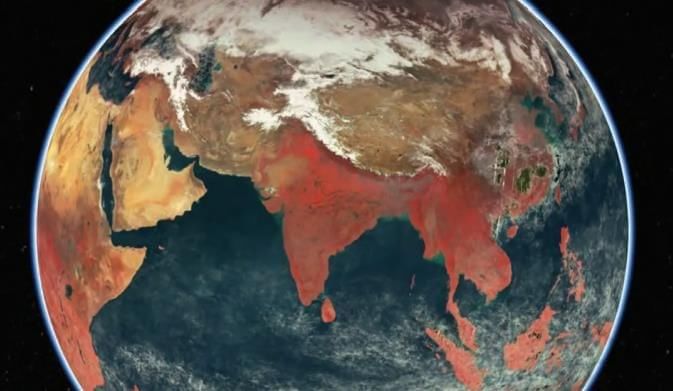 Image by Earth Observation Satellite (ISRO)
Image by Earth Observation Satellite (ISRO)
In this final chapter, you’ll explore what makes Earth so uniquely fit for life. As we tie together everything you’ve learned so far, get ready to discover the special conditions that make our home a truly life-sustaining planet.
About the Image:
- The image was captured by an ISRO Earth Observation Satellite.
- It is a mosaic, created by combining nearly 3,000 smaller images.
- This is a false colour image—special colours are used to highlight different types of information.
- Such images help scientists study land, water, plant growth, and environmental changes more clearly.
Why Is Earth a Unique Planet?
Out of the billions of planets in the universe, Earth is the only one we know that has life in so many forms—plants, animals, people, and more.
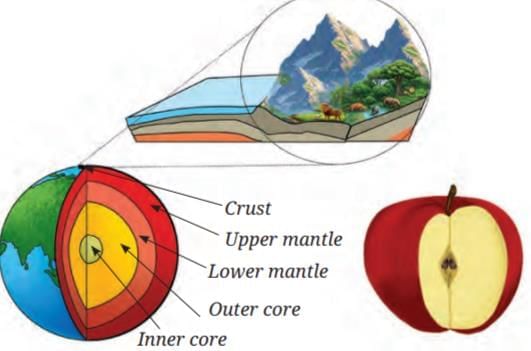 Earth's Crust is like the thin skin of an apple
Earth's Crust is like the thin skin of an apple
- All living things—from the highest mountain to the deepest ocean—exist on a very thin layer on Earth’s surface called the crust.
- If the Earth were the size of an apple, the crust where all life exists would be as thin as the apple’s skin.
- Beneath the crust, there are other layers: upper mantle, lower mantle, outer core, and inner core, but life exists only in the crust.

Activity 13.1: What Makes Earth Special?
Think about and list some interesting features of Earth that we might take for granted, but which matter a lot for our lives. For example:
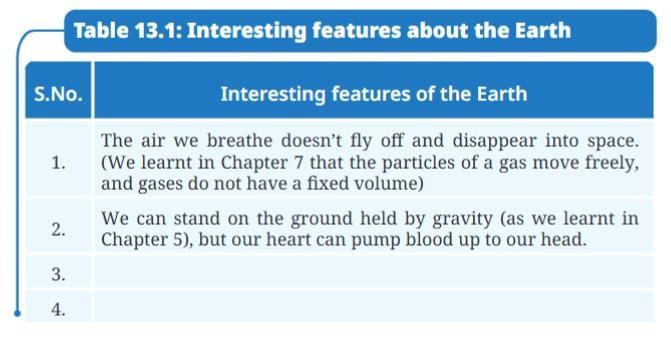
Here is the completed table, but you can add your own observations and discuss:
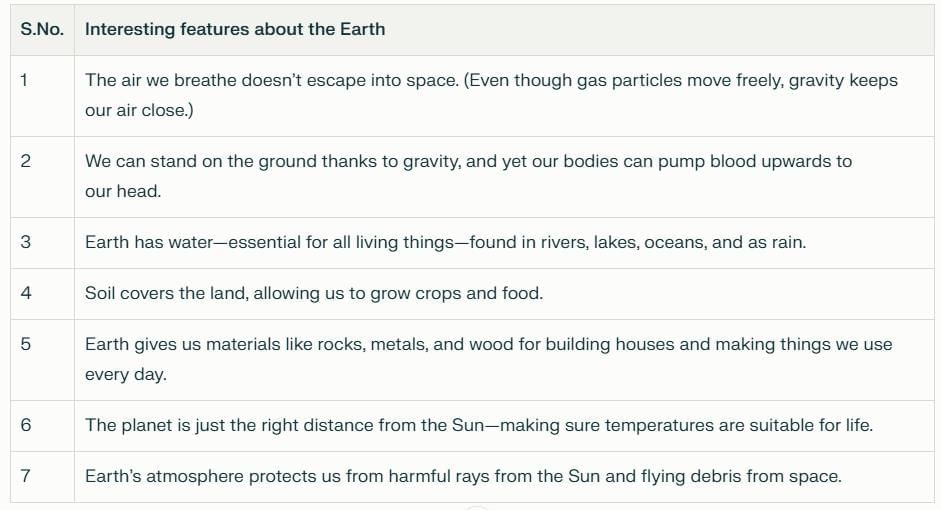
What makes this thin layer so important?
- Though the crust is very thin compared to the whole Earth, it provides everything needed for life.
- Earth gives us the air we need to breathe.
- It provides water for drinking and other needs.
- Soil on Earth helps us grow crops and food.
- Earth supplies materials like rocks, timber, and metals to build homes, buildings, and roads.
- These features make life possible and help us survive and develop.
What Do the Planets of Our Solar System Look Like?
The Solar System has eight planets that move around the Sun in nearly circular paths (orbits).
Planets in order from the Sun:
- Mercury
- Venus
- Earth
- Mars
- Jupiter
- Saturn
- Uranus
- Neptune
Types of Planets:
- Mercury, Venus, Earth, Mars: Smaller, rocky planets.
- Jupiter, Saturn, Uranus, Neptune: Larger, mostly made of gases.
Activity 13.2: Comparing Planets
Collect and compare information about:
- The average temperature of each planet.
- How big it is (radius) compared to Earth.
- Whether it has an atmosphere.
- Fill out the missing information in this table:
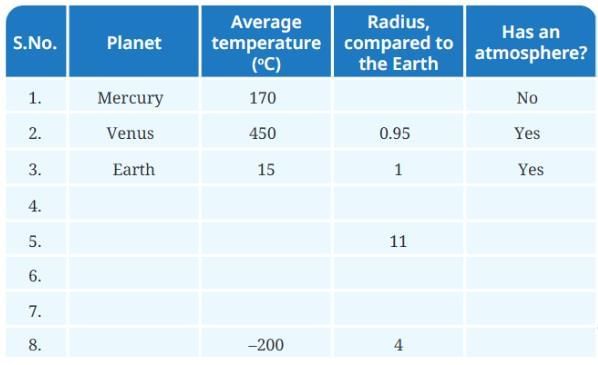
Observation:
- All planets in the solar system get their energy from the Sun.
- Generally, planets closer to the Sun are hotter, and those farther away are colder.
Why Is Venus the Hottest Planet?
- Even though Venus is not the closest planet to the Sun, it is the hottest.
- This is because Venus has a thick atmosphere made almost entirely of carbon dioxide.
- Carbon dioxide traps heat—this is called the greenhouse effect.
- On Venus, the greenhouse effect is very strong, so the planet is even hotter than Mercury.
On Earth: The greenhouse effect also works, but less strongly. Gases like carbon dioxide trap some of the heat radiated from Earth, keeping the planet warm enough for life.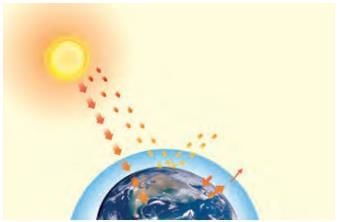
Difference between planetary and plant greenhouse:
- On Venus and Earth: Atmosphere traps heat using greenhouse gases.
- In a plant greenhouse: Glass walls trap warm air by keeping it from escaping.
- Both keep things warm, but the process is different.
What Makes the Earth Suitable for Life to Exist?
1. Position of the Earth (“Habitable Zone”)
Earth’s distance from the Sun is just right—not too close and not too far.
- This perfect distance keeps temperatures so that water mostly exists as a liquid, which is essential for all known life.
- If Earth were closer to the Sun: too hot, all water would evaporate.
- If Earth were farther: too cold, all water would freeze.
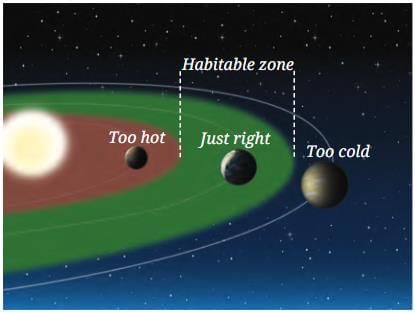 Habitable Zone
Habitable Zone - Liquid water is needed for life to evolve and survive. While some bacteria can live in ice, complex life forms like plants, animals, and humans need liquid water.
- The range around a star where liquid water can exist is called the habitable zone or Goldilocks zone (“just right”—not too hot, not too cold).
- Over 70% of Earth’s surface is covered with water, giving Earth its name: the Blue Planet.
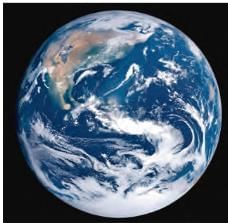 Blue Planet
Blue Planet
Mars and Life: Mars is at the edge of the Sun’s habitable zone.
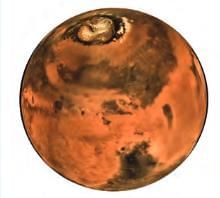 Mars
Mars
- Scientists have sent many spacecraft and rovers to Mars.
- No proof of current life has been found, but Mars may once have had liquid water and simple life.
- Science is open to new discoveries—future missions and studies may change what we know.
2. Size of the Earth and it Atmosphere
Earth’s nearly circular orbit keeps sunlight and temperature across the year mostly steady, preventing extreme burns or freezes.
- Earth’s size is “just right”: If Earth were smaller, its gravity would be too weak to hold the atmosphere. Most gases would escape into space (just like on Mars and Mercury).
- If Earth were much bigger, gravity could be so strong it might crush living things.
- The atmosphere on Earth is essential for life: It provides oxygen for breathing.
- Some atmospheric oxygen turns into ozone, making the ozone layer.
- The ozone layer acts as a shield, blocking harmful ultraviolet (UV) rays from the Sun, which can damage living cells.
- The atmosphere also traps enough heat (greenhouse effect) to keep Earth warm but not too hot.
Our Scientific Heritage: Exploring Mars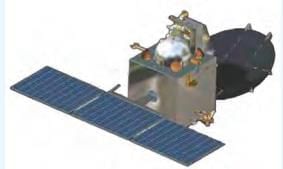 Mangalyaan
Mangalyaan
- India’s Mangalyaan (Mars Orbiter Mission), launched by ISRO in 2013, is a major step in studying Mars.
- This mission studied Mars’ atmosphere, surface, and searched for signs of past water, asking if Mars could ever have supported life.
- Mangalyaan proved India’s space science strength, showing what can be done with low-cost, smart technology.
3. Magnetic Field of the Earth
Along with Earth’s right position from the Sun, size, and atmosphere, the magnetic field is another key factor that makes sure Earth is a safe and life-supporting planet.
- Earth behaves like a giant magnet, which is why a freely suspended magnet (like a compass) always points in a fixed direction.
- The area around a magnet, where its effects are felt, is called the magnetic field.
- Scientists believe that the movement of molten iron in Earth’s core creates Earth’s magnetic field.
Why is Earth’s Magnetic Field Important?
Earth is constantly bombarded by tiny, high-energy particles from space:
- Cosmic rays (from far across the universe)
- Solar wind (charged particles from the Sun)
These particles can be harmful as:
- They can damage the atmosphere,
- Reduce the ozone layer,
- Increase harmful UV rays reaching Earth,
- And harm living things.
The magnetic field acts as a shield:
- It pushes many of these harmful particles away from Earth,
- Helps keep the atmosphere safe,
- Protects living beings and life on our planet.

What Allows Life to Be Sustained on Earth?
Earth has the right conditions for life, but it is the connections between living (biotic) and non-living (abiotic) things that truly help life thrive on Earth.
Air, Water, and Sunlight
- The atmosphere of Earth provides essential oxygen for breathing (respiration) for humans, animals, and plants. Plants, in turn, take in carbon dioxide from the air and water from the soil to produce food through photosynthesis, a process that requires sunlight. During photosynthesis, plants release oxygen back into the air, maintaining the balance needed for life.
- Sunlight is crucial as it heats the surface of the Earth and provides the energy needed for all life processes. Some of this heat is trapped by the atmosphere in what is known as the greenhouse effect, keeping the planet warm enough for water to stay liquid. Without this protective blanket of air, Earth would lose its heat quickly and become too cold for life to exist.
- Water, which covers nearly 70% of Earth's surface and forms the hydrosphere (including ponds, lakes, rivers, seas, oceans, and groundwater), is essential to all living things. Water dissolves and transports nutrients in plants and animals, helps animals regulate temperature and digestion, and ensures hydration.
- The hydrosphere is home to countless species, from tiny plankton to giant whales—many still undiscovered.
- Freshwater is needed for growing crops and supporting people everywhere.
- Water vapor in the air forms clouds, which bring rain and snow, refilling rivers, lakes, and underground sources.
- Rainfall determines what kinds of plants and animals can live in a place. Air movement (wind) also shapes weather and affects when and where it will rain, which influences farming, water supply, and all life on land.
Soil, Rocks, and Minerals
- The Earth’s crust, or geosphere, is made up of rocks, soil, and minerals. This layer provides almost everything that living things need to survive.
- Soil is essential for life. It allows plants to grow and contains nutrients like nitrogen and potassium, which come from the breakdown of rocks and the remains of dead plants and animals.
- Minerals found in rocks and soil are valuable resources—they give us salt, coal, oil, iron, copper, and many other materials needed for building, manufacturing, and daily life.
- Geodiversity means the variety of landforms, rocks, and soils on Earth. This diversity creates different habitats and environments, helping many kinds of plants and animals to live and thrive.
- Non-living parts of nature—like soil, rocks, and water—are not just a background; they play an active role in shaping and supporting every form of life on our planet.
Plants, animals, and microorganisms
The biosphere is the zone where life exists on Earth—including land, water, and the lower atmosphere. It contains all living things: trees, shrubs, herbs, animals, insects, and even microscopic organisms like bacteria and fungi.
Every living thing is connected.
- Plants use photosynthesis to make their own food from sunlight, water, and carbon dioxide.
- Animals depend on plants (and sometimes other animals) for food and energy.
- Microorganisms (like bacteria and fungi) are decomposers. They break down dead plants and animals, returning valuable nutrients to the soil and making them available for new life.
- These connections mean all living beings depend on one another and on their environment, working together in a balance that supports life on Earth—this is the essence of ecology.
The Importance of Balance
- Earth is a massive, interconnected system—land, air, water, and life forms all interact.
- Even small changes (like cutting down forests) can impact rainfall, soil quality, air, and animals.
- Life is possible because everything stays balanced—preserving this balance is essential for a healthy and habitable Earth.
- Protecting clean air, water, soil, and all forms of life keeps Earth healthy for the future.
What Keeps Life from Disappearing?
If plants and animals did not reproduce, living things would eventually disappear from Earth.
What is Reproduction?
- Reproduction ensures that every kind of organism continues, helping life last through generations.
- Usually, young ones look similar to their parents (cows have calves, cats have kittens) because parents pass down instructions, called genes or genetic material, to their offspring.
- Genes work like an instruction manual inside every cell, telling it how to form different body parts.
Why is Reproduction Important?
- Keeps each species (type of organism) going, generation after generation.
- Allows for small changes (variations) in genes over time.
- Sometimes these changes help living things survive better in their environment (e.g., camels evolved humps for desert survival).
- Microbes can become resistant to antibiotics.
- Over many generations, these small changes can build up and even create new types of living beings.
How Can Offspring Be Similar Yet Different?
Reproduction can lead to both similarity (children look like their parents) and variety (differences, like height or colour). There are two main types of reproduction:
- Asexual reproduction: New organisms are almost exact copies of the parent.
- Sexual reproduction: Offspring have features from both parents, with some differences.
Asexual Reproduction
In Asexual reproduction, one parent produces new individuals, which are genetic copies.
Example: Many plants can reproduce when any part of the plants—leaf, stem, or root—is planted in soil. This kind of reproduction is called vegetative propagation.
Activity 13.3: Vegetative Propagation in Plants
- Plant stem cuttings (e.g., money plant), potato eyes, or pieces of ginger in moist soil.
- Give them water, air, and sunlight.
- Observe daily to see when roots, stems, and new leaves appear.
- This shows how some plants can grow new individuals from just a part of the original plant.
Other examples of Asexual Reproduction (besides plants):
- Bacteria, amoeba: Divide into two identical individuals.
- Algae, Planaria: Can regrow from small pieces.
- Hydra: Grows buds that break off to form new individuals.
- Planaria: Flatworm can regrow from a fragment (studied for regeneration).
Sexual Reproduction
Sexual reproduction is the process by which two parents, usually called male and female, give rise to new offspring.
This is common in almost all animals and flowering plants. Even some microorganisms, like certain bacteria and yeast, have mating types that act like two parents.
Special Cells for Reproduction: Gametes
Both parents produce special reproductive cells called gametes.
- Male gametes (sperm in animals, pollen in plants)
- Female gametes (egg in animals, ovule in plants)
Gametes carry half the genetic information of each parent. When male and female gametes combine (a process known as fertilisation), they form a single new cell called a zygote. The zygote contains a complete set of genetic instructions—half from each parent.
Why Don’t Babies Look Exactly Like Their Parents?
- Every offspring gets a unique mix of genetic material from both parents.
- That is why babies, calves, kittens, or chicks are similar to their parents but do not look exactly the same.
- Even siblings can have different features, like different eye or hair color, depending on which genes are inherited.
- This mixing of genes provides variation, which is important for evolution and adaptation.
Sexual Reproduction in Plants
- Flowering plants have both male and female parts:
- Anther (male part): Produces pollen grains (male gametes).
- Ovule (female part): Found inside the ovary of the flower; contains female gametes. - Pollination: Pollen is transferred (by wind, insects, or animals) from the anther to the stigma of a flower, often a different flower.
- Fertilisation: Pollen reaches the ovule, and gametes fuse to form a zygote inside the ovule.
- The zygote develops into a seed.
- The ovule becomes the seed, and the surrounding part of the flower develops into a fruit. Seed Dispersal: Fruits are often eaten by animals or birds, who carry the seeds far from the parent plant. When seeds fall in a suitable spot with sufficient water, they use stored food to grow roots and shoots (germination).
Sexual Reproduction in Animals
Animals have two types of reproductive cells: sperm (male) and egg (female).
- Fertilisation happens when a sperm and an egg join to form a new cell called a zygote.
- In fish and frogs, fertilisation takes place in water. Both parents release their sperm and eggs into the water, where they combine. The embryo then develops in the water.
- In birds and mammals (including humans), fertilisation takes place inside the female’s body. The male deposits sperm, which swim to meet the egg.
After fertilisation:
- In birds, the female lays an egg. The embryo develops inside the egg, using food stored in the egg until it hatches.
- In mammals, the embryo develops inside the mother’s body. The mother provides all food and oxygen until the baby is born.
- The main difference:
- Birds (and reptiles) lay eggs, providing food for the embryo in the egg itself.
- Mammals usually give birth to live young, supplying nutrition directly inside the body. Each way of reproduction helps the baby animal grow safely, depending on what’s best for the animal’s survival.
What Are the Threats to Life on Earth?
Earth’s life depends on a delicate balance between living things (plants, animals, microbes) and non-living things (air, water, soil, sunlight). Human actions are disturbing this balance, leading to big environmental problems.
The three main global challenges today:
- Climate Change
- Biodiversity Loss
- Pollution
1. Climate Change
- Caused by burning fossil fuels (coal, oil, gas), which release greenhouse gases like carbon dioxide and methane.
- These gases trap more heat in the atmosphere, causing global warming.
- Normally, carbon dioxide is absorbed by plants, trees, and plankton in oceans, keeping things in balance.
- However, when we burn fossil fuels, we release extra carbon locked away underground for millions of years. Earth cannot absorb it fast enough, so more heat gets trapped.
- Even a small temperature increase can:
- Melt ice caps and raise sea levels, leading to floods in coastal cities.
- Cause more extreme weather—like heavier rains, stronger storms, longer droughts, and heatwaves.
- Make some plants and animals disappear forever. Long-term changes in temperature, rainfall, and weather caused by this are called climate change.
2. Biodiversity Loss
Destroying natural habitats (forests, grasslands, wetlands) makes plants and animals disappear.
This upsets food chains and ecosystems:
- If grasses vanish, plant-eating animals (like deer and grasshoppers) lose their food.
- Without herbivores, predators (like tigers or foxes) cannot survive.
Every species has a role—losing any weakens nature’s ability to support life.
3. Pollution
Air Pollution:
- Comes from factories, vehicles, and burning fuels.
- Harms human health, leads to breathing problems, damages crops, and causes smog and acid rain.
Water and Soil Pollution:
- Caused by factory waste, farm chemicals, and plastic.
- Harms aquatic life, makes water unsafe, and lowers crop yields.
- Polluted soil can spread toxins through the food chain.
All these problems together harm people, animals, plants, and ecosystems.
The Importance of Balance
- Small changes in global temperature, oxygen, or the ozone layer can endanger all life.
- All Earth’s systems—hydrosphere (water), biosphere (living things), atmosphere (air), geosphere (rocks, soil)—are connected.
- Harm to one system spreads to others.
What Are We Doing About It? (Global Actions)
Countries have agreed on important treaties to protect Earth:
- Montreal Protocol (1987): Reduced chemical pollution; helped the ozone layer recover.
- Earth Summit (1992): United nations to work together on climate and biodiversity.
- Kyoto Protocol (2005) and Paris Agreement (2015): Countries committed to lowering greenhouse gas emissions.
- Paris Agreement goal: Keep global warming below 1.5°C.
- As of 2025, the world has not reached this goal—more action is needed.
How Can We Help?
- Cut down on pollution.
- Switch to cleaner energy: Use solar, wind, and renewable energy instead of coal and oil.
- Use energy and water carefully: Turn off lights, don’t waste water, and travel in eco-friendly ways.
- Reduce, reuse, and recycle: Fix, repair, and recycle clothes, plastic, and other items to produce less waste.
- Practice sustainable farming and waste management to protect soil and water.
- Protect biodiversity: Healthy, diverse ecosystems are stronger and support more life.
- Local communities can manage natural resources wisely and make a big difference.
FAQs on Our Home: Earth, a Unique Life-Sustaining Planet Chapter Notes - Chapter Notes For Class 8
| 1. Why is Earth considered a unique planet in our solar system? |  |
| 2. What are the main characteristics of the other planets in our solar system? |  |
| 3. What makes Earth suitable for life to exist? |  |
| 4. What processes allow life to be sustained on Earth? |  |
| 5. What factors help prevent life from disappearing on Earth? |  |
















